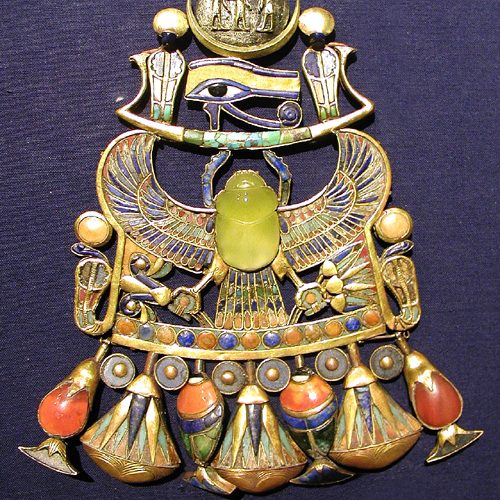The ancient Egyptians exhibited a love of ornament and personal decoration from earliest Predynastic times. Badarian burials often contained strings of beads made from glazed steatite, shell and ivory. Jewelry in gold, silver, copper and faience is also attested in the early Predynastic period; more varied materials were introduced in the centuries preceding the 1st Dynasty. By the Old Kingdom, the combination of carnelian, turquoise and lapis lazuli had been established for royal jewelry, and this was to become standard in the Middle Kingdom. Less sophisticated pieces might use bone, mother-of-pearl or cowrie shells. The particular choice of materials depended upon practical, aesthetical and symbolic considerations. Some types of jewelry remained perennially popular, while others went in and out of fashion. In the first category were bead necklaces, bracelets, armlets and girdles. Bead aprons are first attested in the 1st Dynasty, while broad collars became a standard type from the early Old Kingdom. In the Middle Kingdom, they had fallen from favor, to be replaced by finger-rings and ear ornaments (rings and plugs). New Kingdom jewelry is generally more elaborate and garish than that of earlier periods, and was influenced by styles from the Ancient Greece and the Levant. Many fine examples were found in the tomb of Tutankhamun. Jewelry, both royal and private, was replete with religious symbolism. It was also used to display the wealth and rank of the wearer. Royal jewels were always the most elaborate, as exemplified by the pieces found at Dahshur and Lahun, made for princesses of the 18th Dynasty, favored courtiers were rewarded with the “gold of honor” as a sign of royal favor.
The techniques of jewelry-making can be reconstructed from surviving artifacts and from tomb decoration. A jeweler’s workshop is shown in the tomb of Mereruka; several New Kingdom tombs at Thebes contain similar scenes.
Amulets
An amulet is a small charm worn to afford its owner magical protection, or to convey certain qualities (for example, a lion amulet might convey strength, or a set-square amulet might convey rectitude). Attested from the Badarian period onward, amulets were produced both for the living and the dead. Particular amulets were placed at specific places in the mummy wrappings. The heart scarab was a specialized form of amulet to protect the heart of the deceased in the afterlife. Amulets were made from a wide variety of materials, including faience, glass, and precious stones – with color often playing an important symbolic role – and in a wide variety of forms. They might depict sacred objects (such as the Djed pillar, Tyet girdle or Wedjad eye); animals (bull’s head amulets were particularly common in the late Predynastic period); or hieroglyphs (for example, Ankh or Sa). From the New Kingdom onward, deities – especially household deities such as Bes and Taweret – were popular subjects for amulets.
Scarab-shaped amulets
The protective amulet for the heart was in the form of the scarab beetle, the manifestation of the creator and solar deity Khepri. It was a symbol of new life and resurrection. The scarab beetle was seen to push a ball of mud along the ground, and from this came the idea of the beetle rolling the sun across the sky. Subsequently, the young beetles were observed to hatch from their eggs inside the ball of mud, hence the idea of creation: life springs forth from primordial mud.
The heart scarab was a large scarab amulet which was wrapped in the mummy bandaging over the deceased’s heart. It was made from a range of green and dark-colored materials, including faience, glass, glazed steatite, shist, feldspar, hematite and obsidian. Black was also associated with the afterlife, while blue and green were associated with the birth and the life-giving waters of the Nile.
